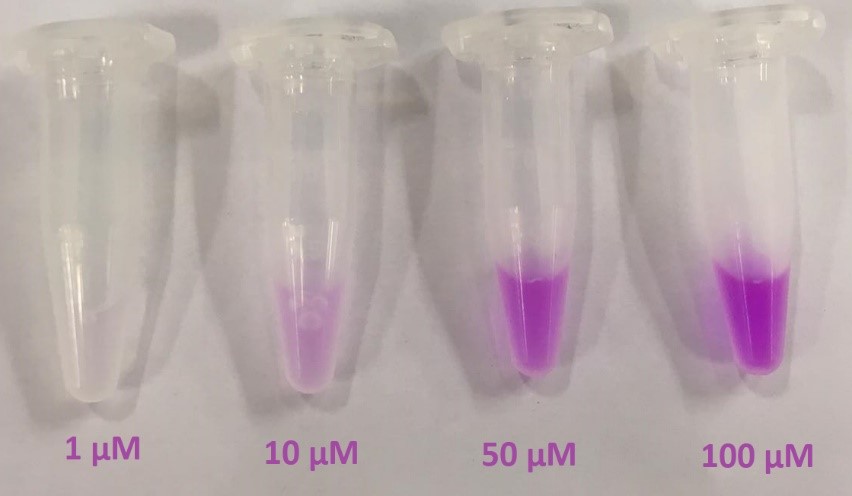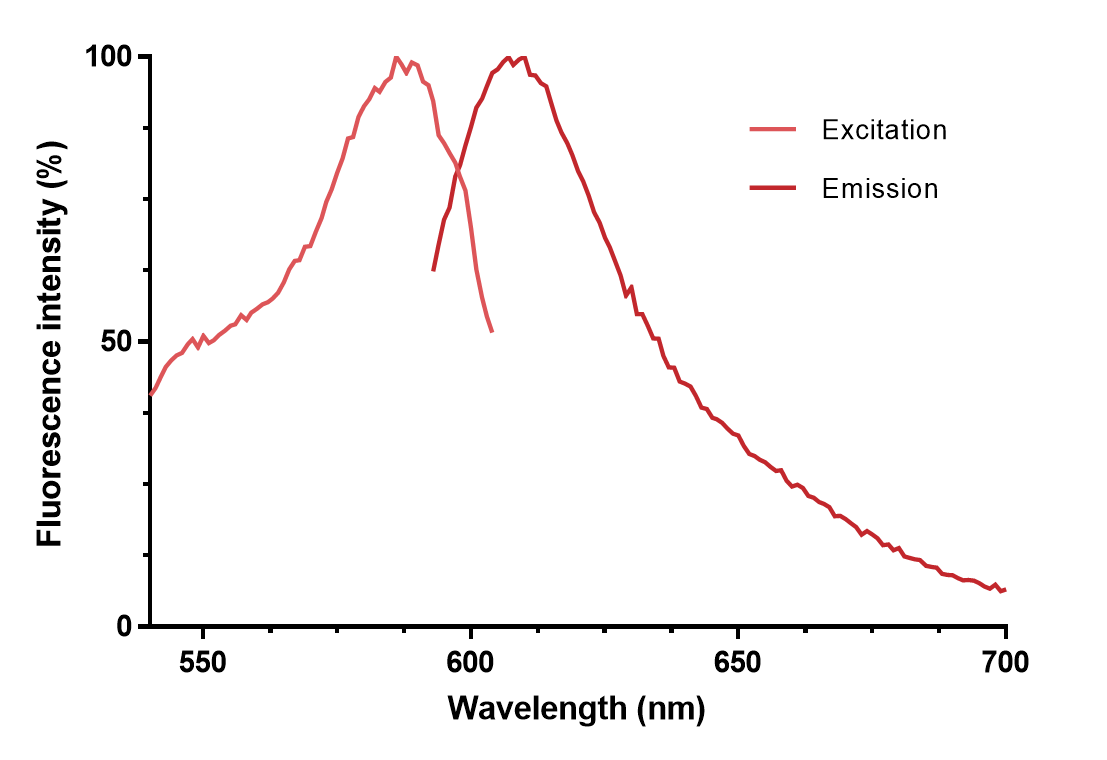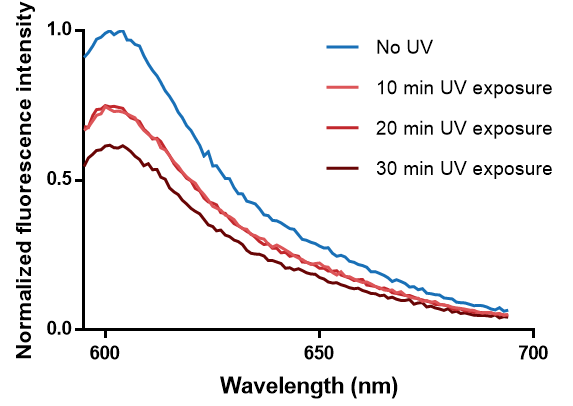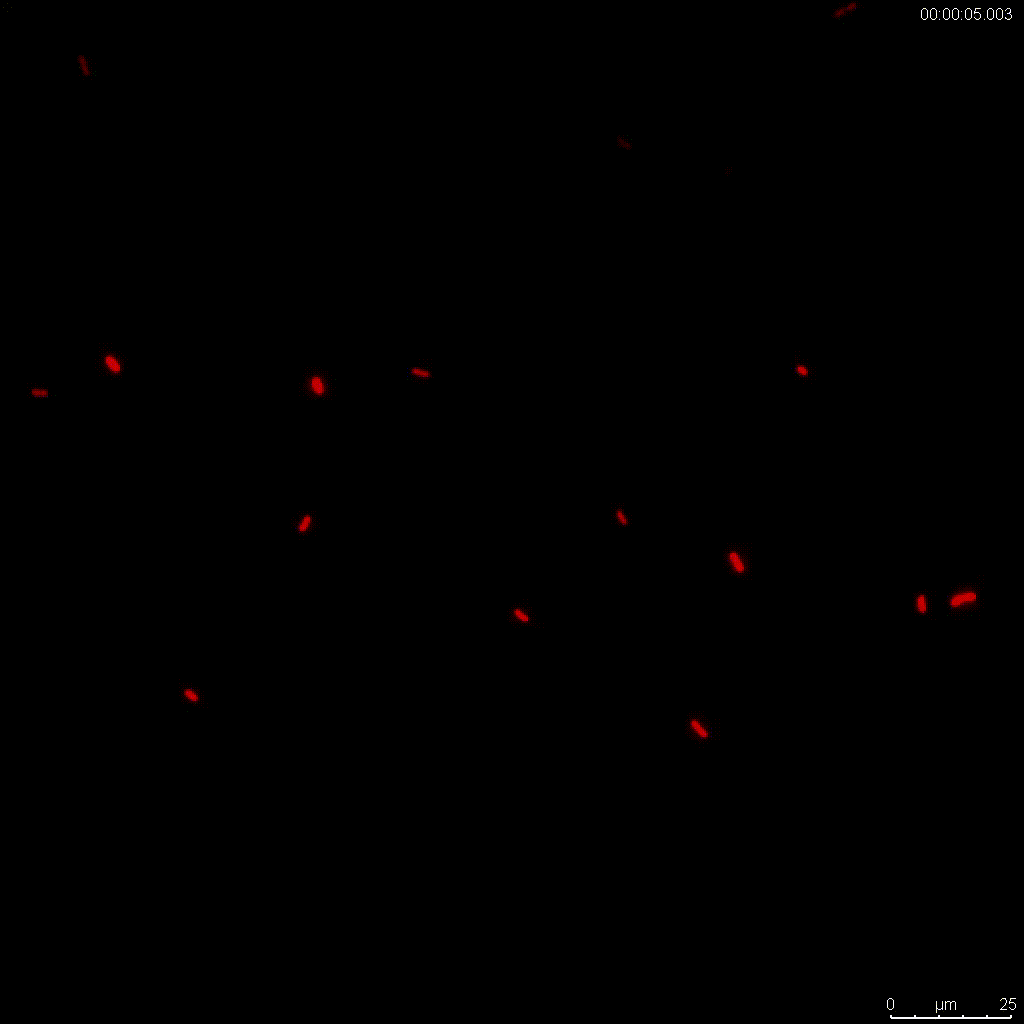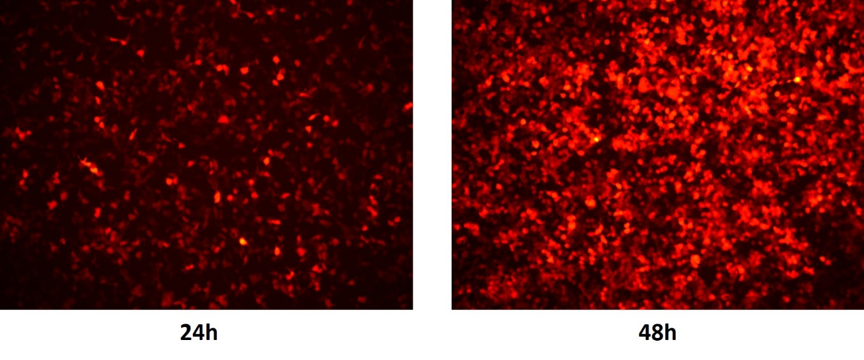Difference between revisions of "Part:BBa J06504"
(→References) |
|||
| Line 53: | Line 53: | ||
[[File:T--HUBU WUHAN--curve of halflife.png|600px|thumb|center| Fig.1 Curve fit of relative intensity.]] | [[File:T--HUBU WUHAN--curve of halflife.png|600px|thumb|center| Fig.1 Curve fit of relative intensity.]] | ||
| + | ==Characterization: SMMU-China 2019== | ||
| + | In our project this year, we aim to develop a biomedical tattoo that could detect disease related molecules and output signals through accumulation of fluorescent proteins. We have also developed a software to analyze the intensity of the fluorescence so that this signal could reflect the disease conditions. To test whether this software could accurately measure the fluorescence and whether florescent proteins are sensitive enough to meet our conception, we carried out the following experiments: | ||
| + | First, we cloned this part (BBa_J06504) into eukaryotic expression vector pcDNA3.1 and transfected it into HEK293T cells through Lipofectamine 2000 transfection reagent. Twenty-four and 48 hours after transfection, bright red light could be observed under florescence microscopy (Figure. 1) | ||
| + | [[File:T--SMMU-China--mCherry 1.png|600px|thumb|center| Figure. 1 mCherry expression at 24 and 48 hours after transfection.]] | ||
| + | |||
| + | The transfected and untransfected HEK293T cells were digested at 24h by trypsin and centrifugated in microtubes. The cells in microtubes were used to mimic the biomedical tattoo and were further examined. Whereas the cells did not show apparent difference with negative control under white light (Figure. 2a), they emitted red light when exposed to exciting light from a mercury lamp (Figure. 2b). This result suggested that fluorescent proteins were sensitive reporters and could be distinguished even by naked eyes under exciting light. | ||
| + | [[File:T--SMMU-China--mCherry 2.png|850px|thumb|center| Figure. 2 Tattoo cells under white light and exciting light. a, From left to right are mCherry, eGFP, and blank cells. These cells did not show apparent difference under white light. b, Florescent cells and blank cells exposed to exciting light.]] | ||
| + | |||
| + | To demonstrate that the software was able to accurately measure fluorescent intensity of tattoo cells, we diluted mCherry-293 cells to a panel of concentrations by mixing with blank cells (Figure. 3), and made a standard curve (Figure. 4). The percentage of mCherry-293 cells in diluted cells were 20%, 40%, 60%, 80%, and 100%, respectively. The standard samples were taken photos by a camera and their fluorescence intensity was measured by using the software to analyze the photos. The standard curve was shown in Figure. 4. | ||
| + | [[File:T--SMMU-China--mCherry 3.png|1100px|thumb|center| Figure. 3 Fluorescence of standard samples of different concentrations.]] | ||
| + | [[File:T--SMMU-China--mCherry 4.png|600px|thumb|center| Figure. 4 Standard curve of fluorescence intensity of different concentrations]] | ||
| + | We also made two samples whose concentrations were 45% and 70%, respectively. Their fluorescence intensity measured by the software were 41.810 and 60.634. Concentrations were calculated by putting the numbers into the standard curve and the results acquired were 44.5% and 69.8%, which were very close to the true value 45% and 70%. | ||
| + | |||
| + | These results demonstrated fluorescent proteins such as mCherry were sensitive and could be measured quantitively by our software. | ||
Revision as of 12:25, 17 October 2019
monomeric RFP optimized for bacteria
mRFP1-derived, altered to be a BioBrick by removing a PstI site and adding BioBrick ends. [mRFP1 was itself a derived from DsRed (via 33 mutations!)]
mCherry is one of several "second-generation" monomeric fluorescent proteins developed in Roger Tsien's laboratory at UCSD (cf., Nature Biotechnology 22, 1567 - 1572 (2004). PMID 15558047
Usage and Biology
Some strange experimental results that have been seen could be explained by an internal RBS + start. The 10th amino acid is a Met which is preceded by AGGAGGA(NNNN). This is almost a perfect consensus RBS so it seems quite likely that translation can begin 10 amino acids in. Note that mCherry was designed by fusing the N and C terminal regions of EGFP on to a mRFP variant (to increase tolerance to protein fusions). Thus, removing the first several amino acids is not expected to have much effect on fluorescence. If this is truly a strong internal RBS, then the identity of any attached RBS may have little effect. Also, one should be careful when making protein fusions. --Austin
The copy as provided in the 2010 distribution is incorrect - it contains ~500 bp of something that is not mCherry between the VF2 and VR sites. You can get a functioning copy via PCR out of Part:BBa_J06702. --[http://openwetware.org/wiki/User:Joseph_T._Meyerowitz jmeyerow]
Improvement by SYSU-CHINA 2016
This part has been improved to be the mCHERRY UNIT including a degradation tag named DBOX, a fluorescent gene mCherry and an sv40 terminator flanked by homodromous recognition site of recombinase VIKA named Vox. The whole part can be cut off by VIKA. For more information of the improved part, please go to the page of Part:BBa_K1926013.
Improvement by USP_UNIFESP-Brazil
The reporter mCherry has been codon-optimized for Chlamydomonas reinhardtii and it was successfully tested as a reporter in this chassis. We have made several measurements to show its fluorescence in Chlamydomonas reinhardtii as well its properties (Fluorescence excitation/emission spectrum). For more information of the improved part, please go to the page of Part:BBa_K2136016.
Improvement by Evry_Paris-Saclay 2017
The reporter mCherry has been codon-optimized for Escherichia coli K12 (Part:BBa_K2448004) and it was successfully tested as a reporter in this chassis. We have used this part to build the Universal Biosensing Chassis (BBa_K2448023 and BBa_K2448024) and test our Psicose Biosensors (BBa_K2448025, BBa_K2448026, BBa_K2448027, BBa_K2448028, BBa_K2448029, BBa_K2448030 and BBa_K2448031) as well as our Fructose Biosensor (BBa_K2448032). For more information on the improved part, please go to the page of Part:BBa_K2448004.
Improvement by University of Minnesota 2017
The internal RBS-like sequence in this mCherry reporter was removed, and the overall sequence was codon-optimized for E. coli K12. This new part BBa_K2375001 should be more suitable for creating fusion proteins.
Contribution: TU_Eindhoven 2019
In this contribution, we futher characterized mCherry (BBa_J06504). mCherry was cloned into a pET28a(+) vector (containing an N-terminal 6xHis-tag) and subsequently expressed in BL21 (DE3) E. coli and purified using immobilized metal affinity chromatography (IMAC). Different concentrations of mCherry were made and an increase in color intensity was visible (Figure 1).
Figure 1. Purified mCherry in different concentrations, showing a clear increase in color intensity.
Consequently, the purified protein was analyzed on an SDS-PAGE (Figure 2) which shows a clear blob above 25 kDa, corresponding with 6xHis-tagged mCherry’s molecular weight of 29.3 kDa. The blob in between 10 kDa and 15 kDa is a truncated version of mCherry as described by Tripathi [1]. There are other bands visible so the purity is not optimal. However, the contrast between the huge blobs and the other bands is very big.
Figure 2. SDS-PAGE of mCherry after purification.
Following protein purification, the protein functionality was analyzed. Firstly, the excitation and emission of mCherry were measured within its absorption and emission range (Figure 3). This shows a clear excitation maximum at 587 nm and an emission maximum at 610 nm. Secondly, the photostability of mCherry was measured following UV radiation up until thirty minutes to advance usage of mCherry in experiments (Figure 4). Exposure to UV light shows a decrease in fluorescence intensity. After 30 min, the intensity is almost halved compared to no UV exposure.
Figure 3. Excitation and emission spectrum of mCherry.AAAAAAAAAAFigure 4. Excitation spectrum of mCherry after different periods of UV radiation.
HUBU-WUHAN 2019-Characterization
We characterized the bleaching effect in zymomonas mobilis using fluorescent microscopy Leica DMi8. We obtained image information through fluorescence microscope and analyzed it with the Rleative Flourescense Calculator in LAS X.
It is expressed in pEZ-15A plasmid with a PlacUV5 promoter. LAS Z was used to analyze the images and calculate the rate of photobleaching. We obtained a half-life period as t1/2=40.07s
Characterization: SMMU-China 2019
In our project this year, we aim to develop a biomedical tattoo that could detect disease related molecules and output signals through accumulation of fluorescent proteins. We have also developed a software to analyze the intensity of the fluorescence so that this signal could reflect the disease conditions. To test whether this software could accurately measure the fluorescence and whether florescent proteins are sensitive enough to meet our conception, we carried out the following experiments: First, we cloned this part (BBa_J06504) into eukaryotic expression vector pcDNA3.1 and transfected it into HEK293T cells through Lipofectamine 2000 transfection reagent. Twenty-four and 48 hours after transfection, bright red light could be observed under florescence microscopy (Figure. 1)
The transfected and untransfected HEK293T cells were digested at 24h by trypsin and centrifugated in microtubes. The cells in microtubes were used to mimic the biomedical tattoo and were further examined. Whereas the cells did not show apparent difference with negative control under white light (Figure. 2a), they emitted red light when exposed to exciting light from a mercury lamp (Figure. 2b). This result suggested that fluorescent proteins were sensitive reporters and could be distinguished even by naked eyes under exciting light.
To demonstrate that the software was able to accurately measure fluorescent intensity of tattoo cells, we diluted mCherry-293 cells to a panel of concentrations by mixing with blank cells (Figure. 3), and made a standard curve (Figure. 4). The percentage of mCherry-293 cells in diluted cells were 20%, 40%, 60%, 80%, and 100%, respectively. The standard samples were taken photos by a camera and their fluorescence intensity was measured by using the software to analyze the photos. The standard curve was shown in Figure. 4.
We also made two samples whose concentrations were 45% and 70%, respectively. Their fluorescence intensity measured by the software were 41.810 and 60.634. Concentrations were calculated by putting the numbers into the standard curve and the results acquired were 44.5% and 69.8%, which were very close to the true value 45% and 70%.
These results demonstrated fluorescent proteins such as mCherry were sensitive and could be measured quantitively by our software.
References
[1] R. Tripathi, “Functional characterisation of LEA proteins from bdelloid rotifers,” 2012.
Sequence and Features
- 10COMPATIBLE WITH RFC[10]
- 12COMPATIBLE WITH RFC[12]
- 21COMPATIBLE WITH RFC[21]
- 23COMPATIBLE WITH RFC[23]
- 25COMPATIBLE WITH RFC[25]
- 1000COMPATIBLE WITH RFC[1000]

